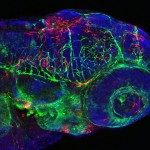Lien vers Pubmed [PMID] – 10611977
Annu. Rev. Cell Dev. Biol. 1999;15:733-98
Synaptic vesicles, which have been a paradigm for the fusion of a vesicle with its target membrane, also serve as a model for understanding the formation of a vesicle from its donor membrane. Synaptic vesicles, which are formed and recycled at the periphery of the neuron, contain a highly restricted set of neuronal proteins. Insight into the trafficking of synaptic vesicle proteins has come from studying not only neurons but also neuroendocrine cells, which form synaptic-like microvesicles (SLMVs). Formation and recycling of synaptic vesicles/SLMVs takes place from the early endosome and the plasma membrane. The cytoplasmic machinery of synaptic vesicle/SLMV formation and recycling has been studied by a variety of experimental approaches, in particular using cell-free systems. This has revealed distinct machineries for membrane budding and fission. Budding is mediated by clathrin and clathrin adaptors, whereas fission is mediated by dynamin and its interacting protein SH3p4, a lysophosphatidic acid acyl transferase.

